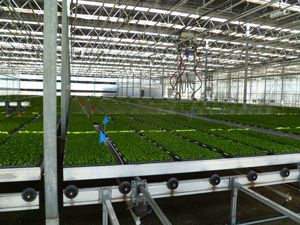10/26/2011
Managing Your Mist
Jason Fatten

Another propagation season is just around the corner. Now is the time to look at how you manage mist during propagation. Proper mist management is critical to rooting success.
The basic principle behind applying mist to vegetative cuttings is simple. Without roots, cuttings cannot adequately replace the water lost to the environment due to evaporation and transpiration mainly. To aid them along the beginning of their life journey we must replace this water loss with water applications. Simple, right? Well, this is a double-edged sword. Excess water will kill cuttings. Cuttings fail to root and disease pressure increases with too much water applied. Mist event scheduling is a function of environmental conditions, and duration and volume of equipment.
Applying mist
There are several tools to apply mist. These range from hand-held sprayers to fixed line nozzles to moving boom sprayers. The deciding factor of what tool to use depends on operation size. A larger propagation area to mist demands a larger tool. If only propagating a tray or two in a small area, a large boom could be too ineffective and expensive. However, a hand-held mister may be too labor intensive, requiring an automated device to trigger a mist event.
Time clock-style mist controllers are a simple way to schedule mist events throughout the day. Low tech, ease of use and understanding this technology are the benefits. However, this method is prone to excess water because mist is applied at regular intervals throughout the day without regard to environmental conditions. Other controllers monitor light levels or relative humidity and use these observations to trigger mist events. Irrigation controllers utilizing vapor pressure deficit (VPD) tend to most accurately predict and trigger mist events. By monitoring plant temperature and relative humidity, calculations are made to predict the rate of water movement from the plant or cutting to the environment. It’s often difficult to understand the math and science behind VPD calculations so trust the computer.
The most sophisticated state-of-the-art technologies are only part of the mist event equation. Nozzle volume and duration are key components of proper mist management.
Most mist nozzles are “low volume,” meaning droplet size is small and applies a low volume usually in terms of gallons per minute (GPM). Low volume doesn’t always mean low water use. Using a low GPM nozzle for a long duration will apply a significant volume of water. How much water do you use to mist?
Follow this simple experiment:
- Weigh 5 dry containers approximately the same size as a tray. Clear plastic domes work well.
- Place containers under the mist system.
- Expose containers to one mist event. For booms, this is the number of passes during one event.
- Weigh wet containers and subtract the dry weight—1 mg = 1 ml of water. Repeat this a few times to get an average of different locations and mist events.
- Take the average volume per mist event and multiply by the average number of mist events applied per day during propagation. Add the water volume of each day that tray would have mist applied and this is the total amount of mist applied during propagation.
Take a close look at the variability between trays. Is this caused by nozzles? We performed this test in our propagation area in our research greenhouses in West Chicago and found we would apply from 1.4 ml to 6.2 ml per tray per mist event. This is a large variability, meaning we need to mist at the 1.4 ml volume longer to apply enough water to our cuttings; however, 10 feet down the bench, trays receiving a 6.2 ml volume at a long duration are flooding!
 How much mist to apply
How much mist to apply
Fresh vegetative cuttings are reliant on water applied through mist. Water-stressed cuttings are slow to form callus, if not desiccate completely. On the contrary, a waterlogged cutting will continue to develop callus and likely rot. Continuously wet cuttings will form large amounts of callus with little or no root initiation. Cuttings need some amount of water stress to promote root formation after callus has formed. The amount of stress is unknown, but propagators begin reducing mist at this stage.
This changes greatly from crop to crop. Closely monitoring the time to callus development and then root initiation gives the scale needed to reduce mist applications. Initially, cuttings need enough water to prevent wilting, but by the time callus formation begins to take place (generally 3 to 7 days), cuttings can wilt slightly between mist events. The transition from callus formation to root initiation is another indicator for mist reduction. Roots begin to uptake more water as they develop further. As this occurs, more water stress can be given to the point where supplemental mist events can be eliminated altogether, relying entirely on irrigation events.
We recently remodeled our mist system. Previously, the 20-year-old nozzles were attached to risers in the middle of the bench, taking up bench space, and nozzles and pipes were filled with biofilm, leading to variability from nozzle to nozzle. This is a small area and with the diversity of crops we propagate, treating each bench individually is the best option for us. We selected a nozzle for uniformity of spray pattern installed in a hanging fashion to free up valuable bench space in the spring. With the new uniformity, we are able to reduce our GPM output. Proper mist scheduling and management is significantly reducing the amount of water applied to our crops.
GT
Jason Fatten is technical manager for Ball Innovations in West Chicago, Illinois.